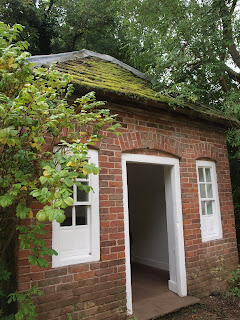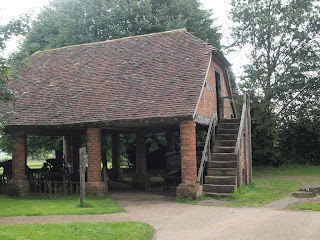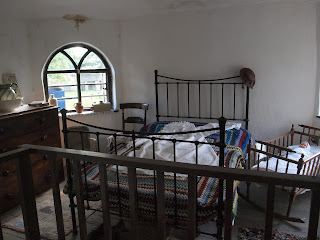Tuesday, 19 September 2017
Avoncroft Museum of Historic Buildings
*D
Last Sunday we went along to the Avoncroft Museum of Historic Buildings near Bromsgrove, Worcestershire and what a superb place it turned out to be.
The idea of such an open air museum was born in 1962 when local people campaigned to stop the demolition of an ancient timber-framed house in Bromsgrove. This medieval Town House was repaired and re-erected and became the museum's first exhibit when it opened in 1967.
The main aim of the museum is to rescue historic buildings that are threatened with demolition. Initially, the focus was on timber-framed buildings but very quickly it started to include buildings of architectural, social and historic interest. Thirty buildings, covering a period of 700 years, from the Midlands Region (Worcestershire, Herefordshire, Staffordshire, Warwickshire, Shropshire, Birmingham and the Black Country) have now been saved from destruction, restored and re-erected at the site. The museum today has a record of architecture and buildings of the area that includes social, agricultural and industrial history. In the main the buildings were dismantled at their original site with bricks and timbers being numbered and then re-erected at the museum. If time has not allowed the rescue of the whole building the main important historic parts were saved and re-assembled as partial buildings. New projects to save buildings are ongoing.
Timothy the Intrepid tagged along on this visit :)
Cattle Market Counting House from Bromsgrove, Worcs, which dates back to 1853 when the market first opened. The rescue of this building was unusual in that it was moved in one piece!
We had a look round the Introductory Exhibition where you can find out how Avoncroft became England's first museum of rescued historic buildings.
*D
Fire surround c1870-1890
Cattle market Counting House to the left and Guesten Hall to the right.
*D
The roof on display in the hall was originally built for Guesten Hall, near Worcester, in the 14th century. It is an important example of a high-status medieval roof. Guesten Hall was built by Wulstan de Bransford, Prior of Worcester, in 1330. The hall itself was demolished in the 1850's after being deemed beyond repair. Afterwards the roof was used in Holy Trinity Church, Worcester, until the church was knocked down in 1969 and the roof was brought to the museum.
There are carved corbels at the base of the roof trusses. In the original Guesten Hall and also at Holy Trinity Church the corbels depicted saints, prophets and medieval animals. These more recently made corbels depict trades and crafts associated with the museum. Some are made of stone and some of wood.
Alex Bele Stenko - Stained Glass Window Maker
Brickmaker and carpenter
String of Horses Inn from Frankwell, Shrewsbury, Shropshire. The building dates back to 1576 beginning life as a mansion before becoming an inn in the late 18th century. Fire damaged the inn in 1912 and it was converted into a shop and it now houses an Edwardian Tea Room.
*D
The museum houses the National Telephone Kiosk Collection
Timothy hoping to hitch a lift on a post office van which unfortunately wasn't going anywhere!
*D
Mission Church from Bringsty Common, Herefordshire
Privy from Townsend House, Leominster, Herefordshire
The Sensory Garden
Threshing Barn from Cholstrey Court Farm, Cholstrey, Herefordshire. This was one of my favourite buildings - just loved the cruck frame. The barn is an important example of a 16th century threshing barn - threshing separated the grain from the stalk of wheat, oats or barley. The two sets of doors, if opened, allowed the wind to blow away the chaff leaving the grain on the floor of the barn. Crucks, which date back to the 12th century, are tall curved timbers usually cut from the same tree, used to make a frame with a beam linking them at the top, they support the roof and walls.
18th century Granary from Temple Broughton Farm, Broughton Green, Worcestershire. The grain was stored on the upper floor away from vermin and where the air could circulate to keep the grain dry. Farm carts could be stored in the open space at the base of the granary.
Windmill from Hill Farm, Danzey Green, Warwickshire. This is a typical West Midlands post windmill where the entire upper structure can be turned round so that the sails always face the direction from which the wind is blowing.
Views of the Worcestershire countryside.
The flowers had mainly gone to seed in the wildflower meadow but it must have looked a picture earlier in the summer.
Late 18th century stable from Ridgeway Court Farm, Wychbold, Worcestershire
A timber Wagon Shed from Beck's Farm, Hanbury, Worcestershire. The shed was constructed near the entrance to Hanbury Hall but was probably used by the farm. It would have stored 4 farm carts and timber from the saw mill.
Chimneys from Swiss Cottage, Fairwater,Cardiff. They are not as old as they look being built in the 19th century and they are an example of Tudor or Elizabethan revival style architecture copying a style that became popular in the early 16th century.
Mid 19th Century Nailer's Cottage from Old Birmingham Road, Lickey End, Bromsgrove - a new project.
Chainshop from Scotia Works, Cradley, Dudley built in the mid 19th century - it was one of about 15 buildings that made up the Scotia works.
Mid 15th century Town House from Worcester Road, Bromsgrove, Worcestershire - the first exhibit of the museum.
A medieval portable oven!
Prefab from Moat Lane, Yardley, Birmingham. Prefabs (factory-made houses) were the temporary answer to the major housing shortage in the Britain after the Second World War. Three million houses had been destroyed or damaged by bombing and new house building had not taken place during the war.
Air-raid Shelters
Toll house from Little Malvern, Worcestershire. Turnpike trusts were set up by Act of Parliament in the 19th century and they were responsible for the upkeep of roads. They were allowed to charge road tolls which were collected at toll gates/houses. The tolls were not popular as there was often a long wait at the gate and travellers saw little improvement in the condition of the roads.
Road-mender's Wagon made by Ricketts Bros, Bewdley, Worcs.
Icehouse from Tong Castle, Tong, Shropshire
Cider apple and perry pear Orchard
Spire from St Paul's Church, Smethwick, Sandwell
Timothy in front of Plas Cadwgan (Cadwgan Hall), from Esclusham, Wrexham Denbighshire.
Dovecote from Haselour Hall, Harlaston, Staffordshire
Bricks from a brick-making display
Hill End Cottage, In situ, Stoke Heath, Bromsgrove. This is the only building on the site to be in its original location and was probably once lived in by an agricultural worker or smallholder. It was built in the 16th or early 17th century and today is used as accommodation for staff.
Time for tea and cake as our visit is almost at an end.
Late 18th century cottage and forge from Wellington, Herefordshire.
*D
There were several other buildings to see including an Airing Shelter, Perry Mill, Nailshop, Racksaw, Cockpit (I steered well clear of this building), a Showman's Wagon and Court Cell Block. Each building has an interesting information board which tells you the history etc.and you can go inside many of the buildings. I only found out about this museum this year and am so glad we visited.
*D - photos taken by D with the Canon Bridge Camera SX50
Reference: Avoncroft Museum Guidebook - well worth buying at £4.95 as it is full of interesting facts about each of the buildings.
Subscribe to:
Post Comments (Atom)














































































12 comments:
What an interesting place to visit, I love looking at things like that! :)
Wow, what a place so pleased people have taken the effort to save these buildings as they could have been lost for ever. I like them all and would love a visit here.
I like the bricks as well on display, have come across stray bricks on my walk especially when we went to Titus Salt old house in the woods, I wish I had got one (not that you really should) as I would have got the builder to put it in our Conservatory wall.
Like the Prefab building and all it's contents, Spire from St Paul's Church, and the tea room looks adorable.
Such a wonderful place so glad you went.
Amanda xx
Pam - Thanks so much - I was really impressed with the museum and the work they do :)
Amanda Peters - Thanks so much. As you say you would love it there. So much of interest to see and read about. Hope to return again one day - it is such good news the way they are able to save the buildings. Hope your porch is progressing well :)
Have you visited our Welsh equivalent at St Fagans, Cardiff? You would love it there too!
Lots to interest at this one. All the bricks we have found around here have, ahem!, "Durex" stamped on the back! Obviously a firm which had a change of plan on what they sold . . .
I loved that stable, and the Herefordshire cottage, and the windmill, and the . . . well, most of it I think! The nail maker's cottage looks like it will be lovely inside.
Thank you for sharing. If we ever live nearer, we will definitely visit.
Bovey Belle - Thanks so much. No, I haven't been to St Fagans - only been to Cardiff once when I was in early 20's to watch rugby match!!
Haha re: the "Durex" bricks!!!
Yes, there were some lovely old buildings there and I do hope you get chance to visit one day - it is definitely worth it :)
It;s a wonderful museum isn't it? I love all the old buildings they have saved especially the town house from Bromsgrove and the windmill, I loved the prefab too. It's a great place to visit and we too had tea and cakes in the old Co-op after wandering round - you could spend all day there:)
Rosie - Thank you and yes it is superb. I found the prefab interesting too - they used to have some of those in a road nearby my parents' house - all gone now though. Yes, we spent about 3.5 hours but could have done with longer.
What a marvellous place; I wish I could walk well enough to visit. I am so pleased that old things are being saved, after all, what might remain of newer things in a hundred years? Thank you for posting it all.
Toffeeapple - Thank you so much - I am so pleased you enjoyed but so sorry to hear about your problems with walking.
Thank you, RR, for your kind comment on my creepy-crawlies! What a brilliant day out Timothy appears to have had, and I love his jumper! The mission church immediately made me think of the chapel here in our Museum of East Anglian Life. I remember playing in an old Anderson shelter as a child...
Caroline Gill - Thanks so much Caroline. I think I might try and knit Timothy a spare jumper one day! :) Thank you for the link and yes you are right they are very similar. I remember air-raid shelters in gardens to each side of my parents' house although we didn't have one in our garden.
piseth san - Thank you for visiting my blog and leaving a comment - so glad you enjoyed the post.
Post a Comment